外研版(2019)选择性必修 第三册Unit2 A life’s work Developing ideas 课件(共34张PPT,内嵌视频)
文档属性
| 名称 | 外研版(2019)选择性必修 第三册Unit2 A life’s work Developing ideas 课件(共34张PPT,内嵌视频) |  | |
| 格式 | pptx | ||
| 文件大小 | 42.0MB | ||
| 资源类型 | 教案 | ||
| 版本资源 | 外研版(2019) | ||
| 科目 | 英语 | ||
| 更新时间 | 2024-04-04 20:19:57 | ||
图片预览


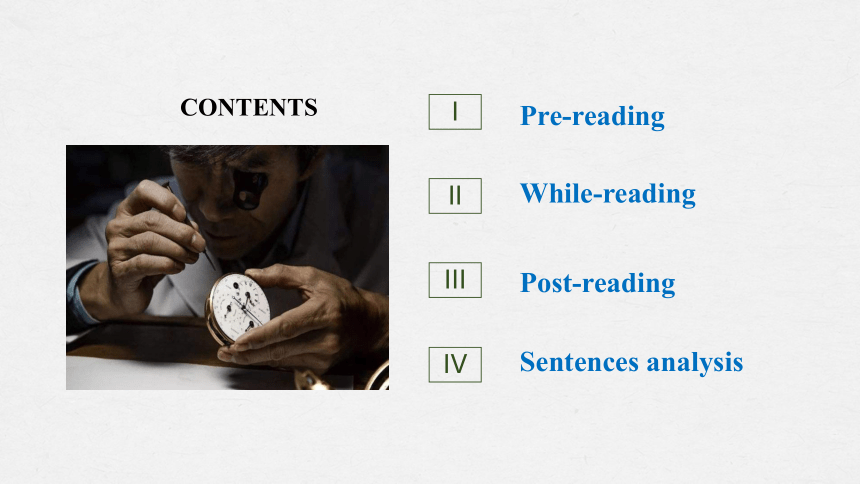
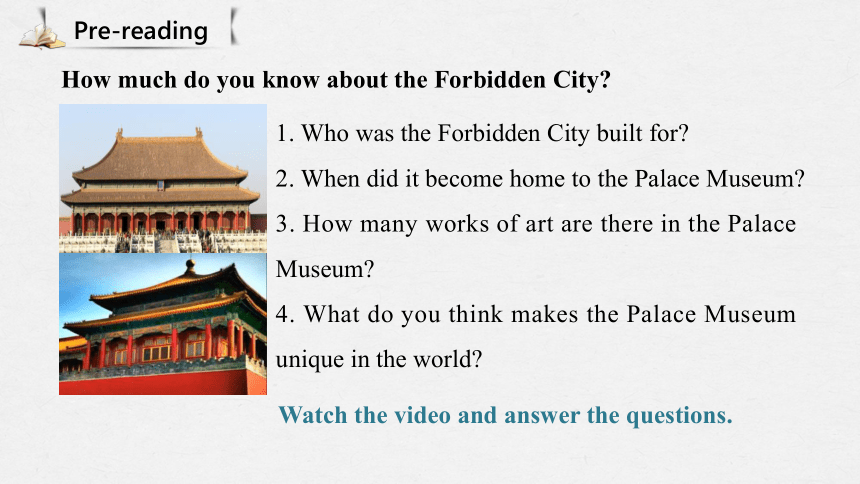
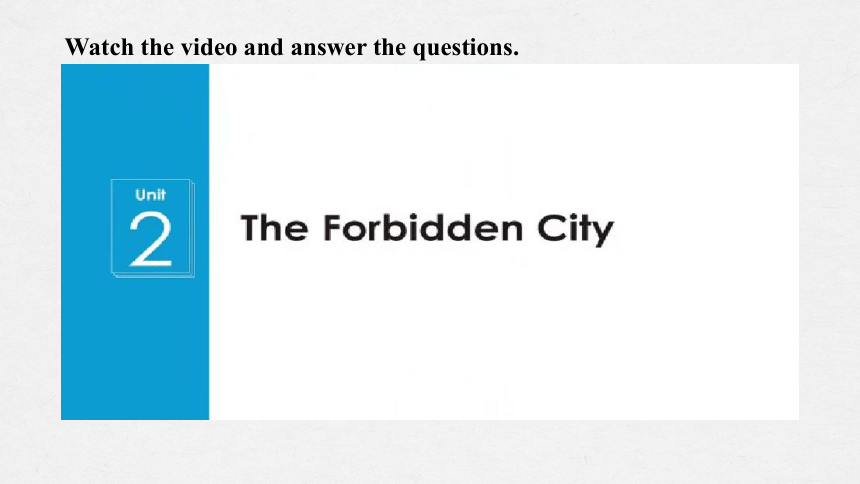
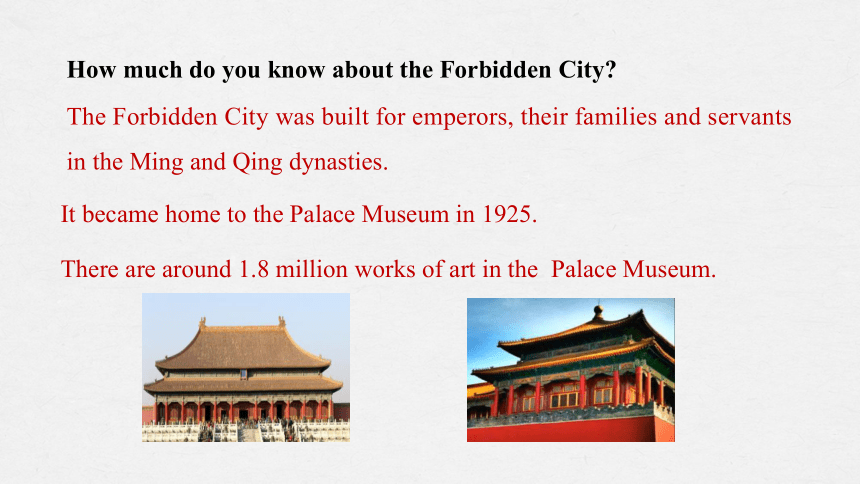

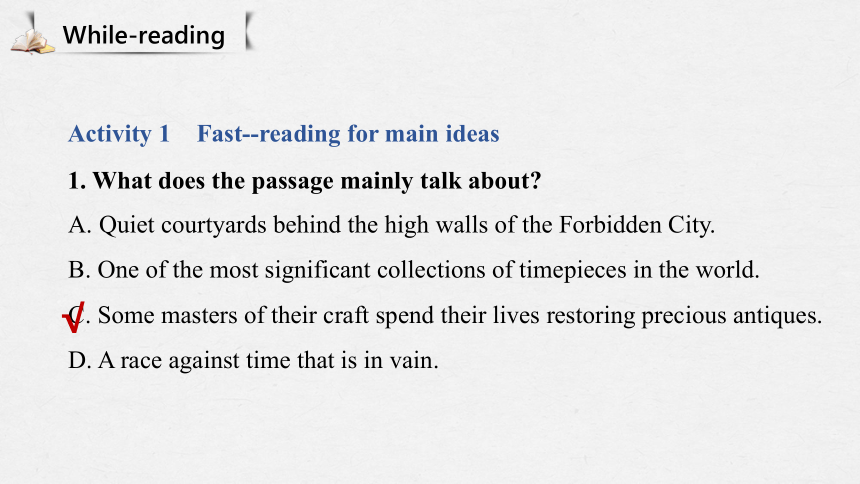
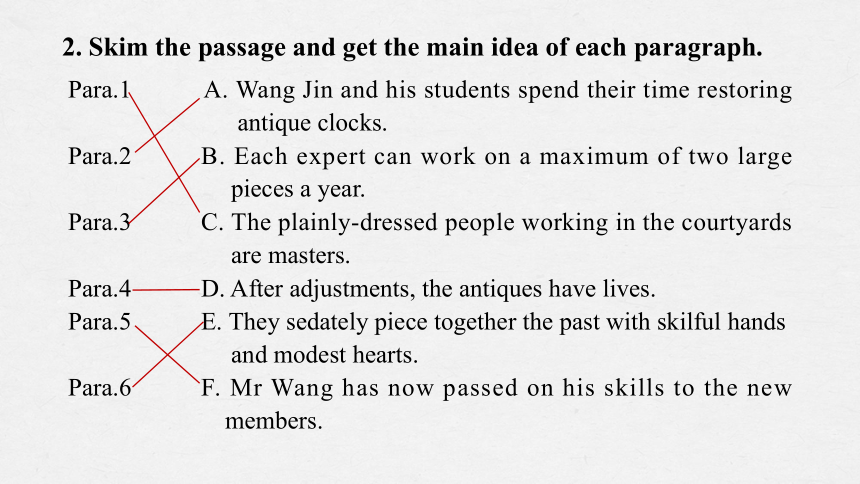
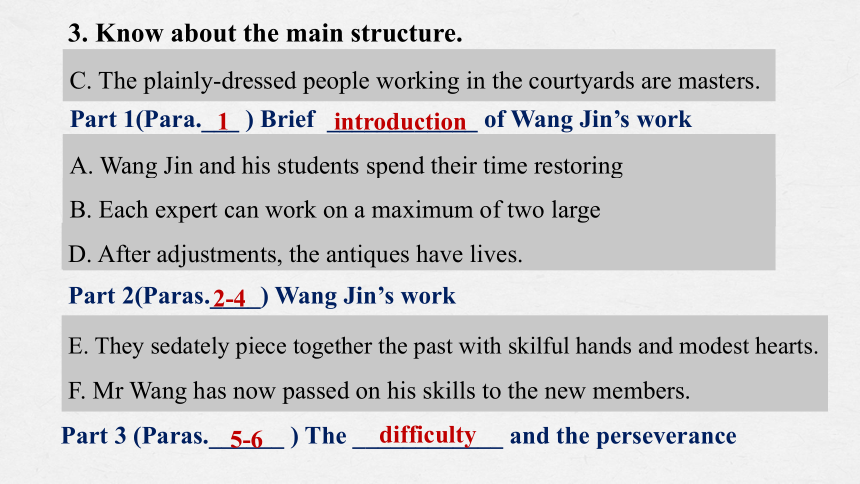
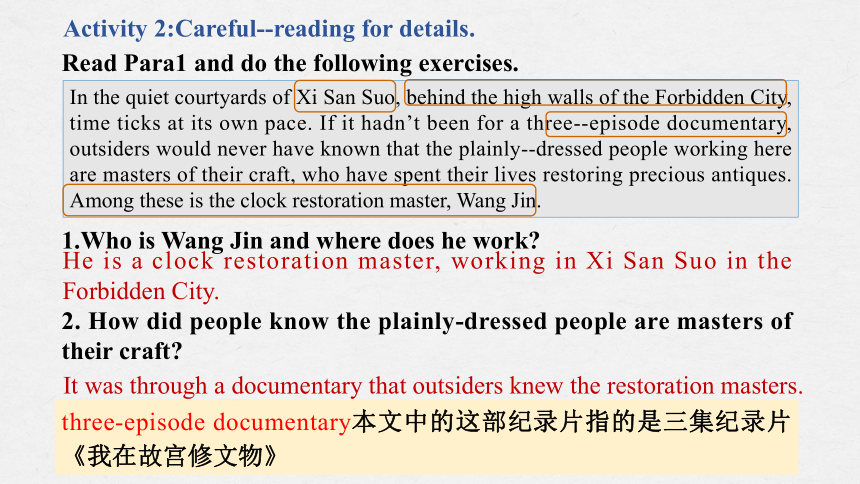

文档简介
(共34张PPT)
Developing ideas
—Reading comprehension
Masters of Time
Unit 2 A life’s work
By the end of this period, students will be able to:
1. know the main idea and structure of this passage;
2. learn about the complexity and perseverance of the clock restoration;
3. experience the spirit of craftsmanship.
CONTENTS
Pre-reading
I
While-reading
II
Post-reading
III
Sentences analysis
IV
1. Who was the Forbidden City built for
2. When did it become home to the Palace Museum
3. How many works of art are there in the Palace Museum
4. What do you think makes the Palace Museum unique in the world
How much do you know about the Forbidden City
Pre-reading
Watch the video and answer the questions.
Watch the video and answer the questions.
How much do you know about the Forbidden City
The Forbidden City was built for emperors, their families and servants in the Ming and Qing dynasties.
It became home to the Palace Museum in 1925.
There are around 1.8 million works of art in the Palace Museum.
Look at the title and the pictures. Predict what the passage is about.
The title shows us that those mentioned in the text are all_______ skilled at the art of ________repairing.
experts
clock
Now let’s read the passage and check our prediction!
While-reading
Activity 1 Fast- reading for main ideas
1. What does the passage mainly talk about
A. Quiet courtyards behind the high walls of the Forbidden City.
B. One of the most significant collections of timepieces in the world.
C. Some masters of their craft spend their lives restoring precious antiques.
D. A race against time that is in vain.
√
2. Skim the passage and get the main idea of each paragraph.
Para.1 A. Wang Jin and his students spend their time restoring
antique clocks.
Para.2 B. Each expert can work on a maximum of two large
pieces a year.
Para.3 C. The plainly-dressed people working in the courtyards
are masters.
Para.4 D. After adjustments, the antiques have lives.
Para.5 E. They sedately piece together the past with skilful hands
and modest hearts.
Para.6 F. Mr Wang has now passed on his skills to the new
members.
3. Know about the main structure.
C. The plainly-dressed people working in the courtyards are masters.
Part 1(Para.___ ) Brief ____________ of Wang Jin’s work
introduction
1
A. Wang Jin and his students spend their time restoring
antique clocks.
B. Each expert can work on a maximum of two large
pieces a year.
D. After adjustments, the antiques have lives.
Part 2(Paras.____) Wang Jin’s work
2-4
E. They sedately piece together the past with skilful hands and modest hearts.
F. Mr Wang has now passed on his skills to the new members.
Part 3 (Paras.______ ) The ____________ and the perseverance
difficulty
5-6
Activity 2:Careful- reading for details.
In the quiet courtyards of Xi San Suo, behind the high walls of the Forbidden City, time ticks at its own pace. If it hadn’t been for a three- episode documentary, outsiders would never have known that the plainly -dressed people working here are masters of their craft, who have spent their lives restoring precious antiques. Among these is the clock restoration master, Wang Jin.
1.Who is Wang Jin and where does he work
He is a clock restoration master, working in Xi San Suo in the Forbidden City.
2. How did people know the plainly-dressed people are masters of their craft
It was through a documentary that outsiders knew the restoration masters.
three-episode documentary本文中的这部纪录片指的是三集纪录片《我在故宫修文物》
Read Para1 and do the following exercises.
Documentary trailer: 《我在故宫修文物》
Read Paras.2-4 carefully and do the following exercises.
1. Why do many people want to take a photo with Wang Jin
A. Because he is a famous film star.
B. Because people admire him for his work.
C. Because he is the director of the Palace Museum.
D. Because they want to make money by taking photos with him.
2.What was special about Wang Jin and his students Qi Haonan
They used to be the only two timepiece restorers in the Palace Museum.
√
...Given the complexity of the work and the lack of necessary materials, this means that each expert can work on a maximum of two large pieces a year. But, through their painstaking efforts, Mr Wang and his students do more than repair the clocks—they bring them back to life.
3. What does the word “this” refer to in the third paragraph
A.Because he isn’t very experienced.
B.Because the timepiece is too large.
C.Because it is difficult for him to find the problem.
D.Because the repair work is complicated and necessary materials are in short.
√
bring …back to life 使……恢复生机
4.Why is it painstaking for Wang Jin and his students to repair the collection of timepieces in the Palace Museum (Para. 3)
Because repairing such a large and important collection of timepieces involves ________work, ________methods of restoration and sourcing difficult-to-find ________, which take a lot of ______, care and attention to detail.
complex
unique
materials
time
5. What is the most beautiful music in the world to Wang Jin (Para. 4)
To Wang Jin the chiming melody of the repaired and polished clocks is the most beautiful music.
chiming melody 钟表报时的旋律
6.What has been done to the clocks that date back to the time of Emperor Oianlong (Para. 4)
Wang Jin has spent eight months adjusting the gigantic clock, which is about to be wound up and brought back to life.
It took so long to bring these antiques lives!Did they finish their work Let’s come to next part .
“these antiques have lives”, it is neither an exaggeration nor a metaphor.
Read Paras. 5-6 and do the following exercises.
1. Why does the author say “it seems unlikely that the restoration of the clocks will ever be complete” in Para. 5
A. Because in the workshop there are other jobs waiting to be done.
B. Because there are so few professional maintenance persons.
C. Because it takes a long time to fix a clock.
D. Because many repaired clocks probably need to be repaired again.
√
Underline the sentences related to the above question.
1. Why does the author say “it seems unlikely that the restoration of the clocks will ever be complete” in Para. 5
But, despite the combined work of several generations of masters, it seems unlikely that the restoration of the clocks will ever be complete. Even if every clock in the Palace Museum were restored, there would still be work to do, because restoration would probably need to begin again on the clocks that were repaired long ago. This is a race against time that can never be won!
This is a race against time that can never be won!
The work is very ___________.
difficult
Do you agree with this Give your reasons.
Possible answer 1: I agree with this because there is always so much work of clock repairing to do.
Possible answer 2: I don’t agree with this because the new generations have grown up. Maybe one day, the work will be complete.
Do you agree with this Give your reasons.(Answers may vary)
2. What is Wang Jin’s attitude towards the future of the timepieces
Wang Jin is optimistic about the future of the timepieces.
Why is Wang Jin optimistic about the future of the timepieces in the Palace Museum (Para. 5)
Following in the footsteps of his own teacher all those years ago, Mr Wang has now passed on his skills to the new members, who will take on many of the future repairs. What’s more, inspired to follow in his father’s footsteps, Mr Wang’s son now has also taken up repairing antique clocks. This new generation of artisans will not only help preserve traditional skills; the innovation they bring to the craft will also ensure that the art of clock repairing stands the test of time.
Because he has passed on his skills to a new generation of artisans, who will not only help preserve __________skills but also bring__________ to the art of clock repairing so that it stands the test of time.
traditional
innovation
What is the main theme of this paragraph?
How the restoration craft pass on from one generation to another.
In today’s fast-paced world, the saying that “time waits for no man” has never seemed more apt. Yet inside the hidden courtyards of Xi San Suo, there is something timeless about the way Mr Wang and his colleagues sedately piece together the past with skillful hands and modest hearts. It is as if they have become one with their craft and with the history of the country.(Para. 6)
What qualities do Wang Jin and his colleagues display in their work
They display qualities of skill, ____________, ___________ and __________ in their work.
patience
modesty
devotion
time waits for no man 岁不我与; 时间不等人
完整谚语:Time and tide wait for no man.
Read the whole passag again and do the following exercises.
1. What’s the genre(体裁) of the passage
A. An advertisement.
B. Narrative writing.
C. Expository writing.
D. Argumentative writing.
2. Which of the following can best describe Wang Jin
A. Devoted and modest.
B. Hard-working and caring.
C. Smart and skilled.
D. Patient and selfless.
√
√
3. In which section may this passage appear
A. Entertainment. B. Health.
C. Education. D. Figure.
4. What figure of speech does the author use in the title “Masters of Time”
I think the author uses the figure of speech(修辞手法) —metaphor (比喻).
√
Post-reading
Students own answers.
1. What can you learn from Wang Jin’s spirit?(Critical thinking)
2. What kind of work do you want to devote yourself to Share your ideas with your classmates.(Creative thinking)
Activity 1 Discussion
From Wang Jin’s experience, I can learn that to do a job well, devotion is key.
Enjoy it !
Activity 2 Summary
If it hadn’t been for a three-episode documentary, outsiders would never have known that Wang Jin,1. ______clock restoration master, who has spent his life 2.________(restore) precious antiques. Although now he is often stopped by admirers wanting their photo 3._______(take) with him, Wang Jin still regards 4._______(him) as an ordinary worker in the Palace Museum. Today, the Palace Museum has one of the most significant 5.__________(collect) of timepieces in the world, 6._______(main) originating from Europe and China. Through their painstaking efforts, Mr Wang and his students do more than repair the clocks—they bring them back 7.____ life.
Wang Jin thinks the sound of the repaired and polished clocks is the 8._____________(beautiful) music in the world. After eight months of endless adjustments, the gigantic clocks 9._____ date back to the time of Emperor Qianlong come back to life. Mr Wang and his colleagues sedately piece together the past with 10.______(skill) hands and modest hearts. It is as if they have become one with their craft and with the history of the country.
a
restoring
taken
himself
collections
mainly
to
most beautiful
that
skillful
Sentences Analysis:
1. If it hadn’t been for a three-episode documentary, outsiders would never have known that the plainly-dressed people working here are masters of their craft, who have spent their lives restoring precious antiques.
[句式分析] 该句是____________句。If引导____________从句,与_______事实相反,句子使用_________;主句主语为__________,that 引导________从句,其中who引导的是______________从句。
[自主翻译]
主从复合
过去
宾语
要不是那三集纪录片,外面的人永远也不会知道,在这
虚拟语气
非限制性定语
outsiders
条件状语
里工作的那些衣着朴素的人竟然都是精于各门技艺的大师,他们毕生都在修复珍贵的古董。
2. Walking through the seven crimson gates towards his workplace, Wang Jin still regards himself as an ordinary worker in the Palace Museum, although now he is often stopped by admirers wanting their photo taken with him.
[句式分析] 该句是__________句;主句为:_____ ;Walking through...为现在分词短语作___________,although引导_________从句,其中 wanting their photo... 为现在分词短语作__________,修饰admirers。
[自主翻译]
主从复合
伴随状语
后置定语
王津穿过七重深红色的大门,走向自己的工作地点。
让步状语
尽管现在他经常被想和他合影的粉丝拦住,他仍然认为自己是故宫博物院的一名普通工人。
3. But for quite some time, he and his student Qi Haonan used to be the only two people repairing timepieces in the Palace Museum.
[句式分析] 此句为_____句。主语为______;used to do意为“___________”,repairing timepieces为现在分词短语作____________,修饰___________。
[自主翻译]
简单
过去常常
后置定语
但在过去相当长的一段时间里,故宫博物院修理钟表
two people
的工匠只有他和他的学生齐昊楠。
4. Given the complexity of the work and the lack of necessary materials, this means that each expert can work on a maximum of two large pieces a year.
[句式分析] 此句为_________句。Given意为“_____________”
that 引导_________从句。
[自主翻译]
主从复合
鉴于,考虑到
宾语
工作的复杂性和必要材料的缺乏意味着每位专家每年
最多只能修复两件大型钟表。
5. It is suddenly clear that when the clock masters say that “these antiques have lives”,it is neither an exaggeration nor a metaphor.
[句式分析] 该句是___________句。it 是_________,第一个that引导______从句;在主语从句中,when引导__________从句,that引导___________。
[自主翻译]
主从复合
形式主语
主语
宾语从句
人们突然明白,当钟表大师们说 “这些古董有生命”时
时间状语
这既不是夸张,也不是比喻。
6. Even if every clock in the Palace Museum were restored,
there would still be work to do, because restoration would probably need to begin again on the clocks that were repaired long ago.
[句式分析] 该句是________句。主句为:___,为________句型;even if引导________从句,because引导__________从句,在此从句中that引导______从句,先行词在从句中作______,故用关系代词that。
[自主翻译]
主从复合
让步状语
there be
原因状语
即使故宫博物院的每一件钟表都被修复了,仍然有工作
定语
主语
要做,因为可能需要重新开始对很久以前修复的钟表进行修复。
7. Following in the footsteps of his own teacher all those years ago,
Mr Wang has now passed on his skills to the new members, who will take on many of the future repairs.
[句式分析] 该句是__________句。主句为:____;Following in the ...为现在分词短语作________,who引导______________从句,take on意为“________”。
[自主翻译]
主从复合
状语
非限制性定语
多年前,王先生继承了师父的事业,而现在他将自己的
承担
技艺传授给了将承担未来许多修复工作的新成员。
Homework
Homework
Write down your ideas about how to pass on traditional skills and the spirit of craftsmanship.
Developing ideas
—Reading comprehension
Masters of Time
Unit 2 A life’s work
By the end of this period, students will be able to:
1. know the main idea and structure of this passage;
2. learn about the complexity and perseverance of the clock restoration;
3. experience the spirit of craftsmanship.
CONTENTS
Pre-reading
I
While-reading
II
Post-reading
III
Sentences analysis
IV
1. Who was the Forbidden City built for
2. When did it become home to the Palace Museum
3. How many works of art are there in the Palace Museum
4. What do you think makes the Palace Museum unique in the world
How much do you know about the Forbidden City
Pre-reading
Watch the video and answer the questions.
Watch the video and answer the questions.
How much do you know about the Forbidden City
The Forbidden City was built for emperors, their families and servants in the Ming and Qing dynasties.
It became home to the Palace Museum in 1925.
There are around 1.8 million works of art in the Palace Museum.
Look at the title and the pictures. Predict what the passage is about.
The title shows us that those mentioned in the text are all_______ skilled at the art of ________repairing.
experts
clock
Now let’s read the passage and check our prediction!
While-reading
Activity 1 Fast- reading for main ideas
1. What does the passage mainly talk about
A. Quiet courtyards behind the high walls of the Forbidden City.
B. One of the most significant collections of timepieces in the world.
C. Some masters of their craft spend their lives restoring precious antiques.
D. A race against time that is in vain.
√
2. Skim the passage and get the main idea of each paragraph.
Para.1 A. Wang Jin and his students spend their time restoring
antique clocks.
Para.2 B. Each expert can work on a maximum of two large
pieces a year.
Para.3 C. The plainly-dressed people working in the courtyards
are masters.
Para.4 D. After adjustments, the antiques have lives.
Para.5 E. They sedately piece together the past with skilful hands
and modest hearts.
Para.6 F. Mr Wang has now passed on his skills to the new
members.
3. Know about the main structure.
C. The plainly-dressed people working in the courtyards are masters.
Part 1(Para.___ ) Brief ____________ of Wang Jin’s work
introduction
1
A. Wang Jin and his students spend their time restoring
antique clocks.
B. Each expert can work on a maximum of two large
pieces a year.
D. After adjustments, the antiques have lives.
Part 2(Paras.____) Wang Jin’s work
2-4
E. They sedately piece together the past with skilful hands and modest hearts.
F. Mr Wang has now passed on his skills to the new members.
Part 3 (Paras.______ ) The ____________ and the perseverance
difficulty
5-6
Activity 2:Careful- reading for details.
In the quiet courtyards of Xi San Suo, behind the high walls of the Forbidden City, time ticks at its own pace. If it hadn’t been for a three- episode documentary, outsiders would never have known that the plainly -dressed people working here are masters of their craft, who have spent their lives restoring precious antiques. Among these is the clock restoration master, Wang Jin.
1.Who is Wang Jin and where does he work
He is a clock restoration master, working in Xi San Suo in the Forbidden City.
2. How did people know the plainly-dressed people are masters of their craft
It was through a documentary that outsiders knew the restoration masters.
three-episode documentary本文中的这部纪录片指的是三集纪录片《我在故宫修文物》
Read Para1 and do the following exercises.
Documentary trailer: 《我在故宫修文物》
Read Paras.2-4 carefully and do the following exercises.
1. Why do many people want to take a photo with Wang Jin
A. Because he is a famous film star.
B. Because people admire him for his work.
C. Because he is the director of the Palace Museum.
D. Because they want to make money by taking photos with him.
2.What was special about Wang Jin and his students Qi Haonan
They used to be the only two timepiece restorers in the Palace Museum.
√
...Given the complexity of the work and the lack of necessary materials, this means that each expert can work on a maximum of two large pieces a year. But, through their painstaking efforts, Mr Wang and his students do more than repair the clocks—they bring them back to life.
3. What does the word “this” refer to in the third paragraph
A.Because he isn’t very experienced.
B.Because the timepiece is too large.
C.Because it is difficult for him to find the problem.
D.Because the repair work is complicated and necessary materials are in short.
√
bring …back to life 使……恢复生机
4.Why is it painstaking for Wang Jin and his students to repair the collection of timepieces in the Palace Museum (Para. 3)
Because repairing such a large and important collection of timepieces involves ________work, ________methods of restoration and sourcing difficult-to-find ________, which take a lot of ______, care and attention to detail.
complex
unique
materials
time
5. What is the most beautiful music in the world to Wang Jin (Para. 4)
To Wang Jin the chiming melody of the repaired and polished clocks is the most beautiful music.
chiming melody 钟表报时的旋律
6.What has been done to the clocks that date back to the time of Emperor Oianlong (Para. 4)
Wang Jin has spent eight months adjusting the gigantic clock, which is about to be wound up and brought back to life.
It took so long to bring these antiques lives!Did they finish their work Let’s come to next part .
“these antiques have lives”, it is neither an exaggeration nor a metaphor.
Read Paras. 5-6 and do the following exercises.
1. Why does the author say “it seems unlikely that the restoration of the clocks will ever be complete” in Para. 5
A. Because in the workshop there are other jobs waiting to be done.
B. Because there are so few professional maintenance persons.
C. Because it takes a long time to fix a clock.
D. Because many repaired clocks probably need to be repaired again.
√
Underline the sentences related to the above question.
1. Why does the author say “it seems unlikely that the restoration of the clocks will ever be complete” in Para. 5
But, despite the combined work of several generations of masters, it seems unlikely that the restoration of the clocks will ever be complete. Even if every clock in the Palace Museum were restored, there would still be work to do, because restoration would probably need to begin again on the clocks that were repaired long ago. This is a race against time that can never be won!
This is a race against time that can never be won!
The work is very ___________.
difficult
Do you agree with this Give your reasons.
Possible answer 1: I agree with this because there is always so much work of clock repairing to do.
Possible answer 2: I don’t agree with this because the new generations have grown up. Maybe one day, the work will be complete.
Do you agree with this Give your reasons.(Answers may vary)
2. What is Wang Jin’s attitude towards the future of the timepieces
Wang Jin is optimistic about the future of the timepieces.
Why is Wang Jin optimistic about the future of the timepieces in the Palace Museum (Para. 5)
Following in the footsteps of his own teacher all those years ago, Mr Wang has now passed on his skills to the new members, who will take on many of the future repairs. What’s more, inspired to follow in his father’s footsteps, Mr Wang’s son now has also taken up repairing antique clocks. This new generation of artisans will not only help preserve traditional skills; the innovation they bring to the craft will also ensure that the art of clock repairing stands the test of time.
Because he has passed on his skills to a new generation of artisans, who will not only help preserve __________skills but also bring__________ to the art of clock repairing so that it stands the test of time.
traditional
innovation
What is the main theme of this paragraph?
How the restoration craft pass on from one generation to another.
In today’s fast-paced world, the saying that “time waits for no man” has never seemed more apt. Yet inside the hidden courtyards of Xi San Suo, there is something timeless about the way Mr Wang and his colleagues sedately piece together the past with skillful hands and modest hearts. It is as if they have become one with their craft and with the history of the country.(Para. 6)
What qualities do Wang Jin and his colleagues display in their work
They display qualities of skill, ____________, ___________ and __________ in their work.
patience
modesty
devotion
time waits for no man 岁不我与; 时间不等人
完整谚语:Time and tide wait for no man.
Read the whole passag again and do the following exercises.
1. What’s the genre(体裁) of the passage
A. An advertisement.
B. Narrative writing.
C. Expository writing.
D. Argumentative writing.
2. Which of the following can best describe Wang Jin
A. Devoted and modest.
B. Hard-working and caring.
C. Smart and skilled.
D. Patient and selfless.
√
√
3. In which section may this passage appear
A. Entertainment. B. Health.
C. Education. D. Figure.
4. What figure of speech does the author use in the title “Masters of Time”
I think the author uses the figure of speech(修辞手法) —metaphor (比喻).
√
Post-reading
Students own answers.
1. What can you learn from Wang Jin’s spirit?(Critical thinking)
2. What kind of work do you want to devote yourself to Share your ideas with your classmates.(Creative thinking)
Activity 1 Discussion
From Wang Jin’s experience, I can learn that to do a job well, devotion is key.
Enjoy it !
Activity 2 Summary
If it hadn’t been for a three-episode documentary, outsiders would never have known that Wang Jin,1. ______clock restoration master, who has spent his life 2.________(restore) precious antiques. Although now he is often stopped by admirers wanting their photo 3._______(take) with him, Wang Jin still regards 4._______(him) as an ordinary worker in the Palace Museum. Today, the Palace Museum has one of the most significant 5.__________(collect) of timepieces in the world, 6._______(main) originating from Europe and China. Through their painstaking efforts, Mr Wang and his students do more than repair the clocks—they bring them back 7.____ life.
Wang Jin thinks the sound of the repaired and polished clocks is the 8._____________(beautiful) music in the world. After eight months of endless adjustments, the gigantic clocks 9._____ date back to the time of Emperor Qianlong come back to life. Mr Wang and his colleagues sedately piece together the past with 10.______(skill) hands and modest hearts. It is as if they have become one with their craft and with the history of the country.
a
restoring
taken
himself
collections
mainly
to
most beautiful
that
skillful
Sentences Analysis:
1. If it hadn’t been for a three-episode documentary, outsiders would never have known that the plainly-dressed people working here are masters of their craft, who have spent their lives restoring precious antiques.
[句式分析] 该句是____________句。If引导____________从句,与_______事实相反,句子使用_________;主句主语为__________,that 引导________从句,其中who引导的是______________从句。
[自主翻译]
主从复合
过去
宾语
要不是那三集纪录片,外面的人永远也不会知道,在这
虚拟语气
非限制性定语
outsiders
条件状语
里工作的那些衣着朴素的人竟然都是精于各门技艺的大师,他们毕生都在修复珍贵的古董。
2. Walking through the seven crimson gates towards his workplace, Wang Jin still regards himself as an ordinary worker in the Palace Museum, although now he is often stopped by admirers wanting their photo taken with him.
[句式分析] 该句是__________句;主句为:_____ ;Walking through...为现在分词短语作___________,although引导_________从句,其中 wanting their photo... 为现在分词短语作__________,修饰admirers。
[自主翻译]
主从复合
伴随状语
后置定语
王津穿过七重深红色的大门,走向自己的工作地点。
让步状语
尽管现在他经常被想和他合影的粉丝拦住,他仍然认为自己是故宫博物院的一名普通工人。
3. But for quite some time, he and his student Qi Haonan used to be the only two people repairing timepieces in the Palace Museum.
[句式分析] 此句为_____句。主语为______;used to do意为“___________”,repairing timepieces为现在分词短语作____________,修饰___________。
[自主翻译]
简单
过去常常
后置定语
但在过去相当长的一段时间里,故宫博物院修理钟表
two people
的工匠只有他和他的学生齐昊楠。
4. Given the complexity of the work and the lack of necessary materials, this means that each expert can work on a maximum of two large pieces a year.
[句式分析] 此句为_________句。Given意为“_____________”
that 引导_________从句。
[自主翻译]
主从复合
鉴于,考虑到
宾语
工作的复杂性和必要材料的缺乏意味着每位专家每年
最多只能修复两件大型钟表。
5. It is suddenly clear that when the clock masters say that “these antiques have lives”,it is neither an exaggeration nor a metaphor.
[句式分析] 该句是___________句。it 是_________,第一个that引导______从句;在主语从句中,when引导__________从句,that引导___________。
[自主翻译]
主从复合
形式主语
主语
宾语从句
人们突然明白,当钟表大师们说 “这些古董有生命”时
时间状语
这既不是夸张,也不是比喻。
6. Even if every clock in the Palace Museum were restored,
there would still be work to do, because restoration would probably need to begin again on the clocks that were repaired long ago.
[句式分析] 该句是________句。主句为:___,为________句型;even if引导________从句,because引导__________从句,在此从句中that引导______从句,先行词在从句中作______,故用关系代词that。
[自主翻译]
主从复合
让步状语
there be
原因状语
即使故宫博物院的每一件钟表都被修复了,仍然有工作
定语
主语
要做,因为可能需要重新开始对很久以前修复的钟表进行修复。
7. Following in the footsteps of his own teacher all those years ago,
Mr Wang has now passed on his skills to the new members, who will take on many of the future repairs.
[句式分析] 该句是__________句。主句为:____;Following in the ...为现在分词短语作________,who引导______________从句,take on意为“________”。
[自主翻译]
主从复合
状语
非限制性定语
多年前,王先生继承了师父的事业,而现在他将自己的
承担
技艺传授给了将承担未来许多修复工作的新成员。
Homework
Homework
Write down your ideas about how to pass on traditional skills and the spirit of craftsmanship.
